Believe it or not, there is even more from the Entertainment Weekly’s interview with Star Trek: Discovery showrunners Aaron Harberts and Gretchen J. Berg. A new article today contains some of what published in the magazine (reported here on Friday) along with some additional new bits, specifically about the influences for the new series.
Speaking of influences Berg said:
“There’s a hint of all of them, but in the writers’ room people are so in love with The Original Series and Next Generation, and they talk about the family aspect of those cast members.”
Harberts added:
“I think Nicholas Myers’ [sic] film are a touchstone, and not just because he’s been on staff with us. His storytelling is complex and intellectual and yet there’s a lot of room for character voices and character work, he’s done such an incredible job with the franchise.”
Aspect Ratios and JJ Abrams’ influence
Much has been said of the cinematic aspirations and style of Star Trek: Discovery. In talking about influences of the show, Harberts expanded on this as well saying…
In terms of scope and scale, there’s something about Star Trek: The Motion Picture that really speaks to us as well. CBS has allowed us to find a cinematic language that’s wider in scope — our aspect ratio is 2:1 — and it just lends itself to a very lyrical way of telling the story. And just visually speaking, there’s also a little hint in terms of what J.J. Abrams did, a little bit, in terms of some of the visuals.”
This 2:1 aspect ratio could be seen in the trailer that was released in May, made apparent by the slight letterboxing. This is a wider aspect ratio than typical TV programming which is made to fill in the standard widescreen HDTV shape of a 16:9 ratio [1.78:1 in theatrical ratio parlance], like Star Trek: Enterprise. The J.J. Abrams Star Trek films (and most of the other Trek films) were done in the wider 2.40:1 ratio which is typical for feature films. The 2:1 ratio has become popular recently with some premium television series, such as Netflix’s House of Cards. The 2:1 ratio is seen as “splitting the difference” between the extra wide cinema format and the typical widescreen HDTV ratio.
The below comparison shows Discovery’s wider aspect ratio compared to Enterprise (standard HDTV ratio of 16:9) and JJ Abrams’ Star Trek (2.40:1), as they would appear on a typical 16:9 HDTV screen.
Keep up with all the Star Trek: Discovery news at TrekMovie.com.

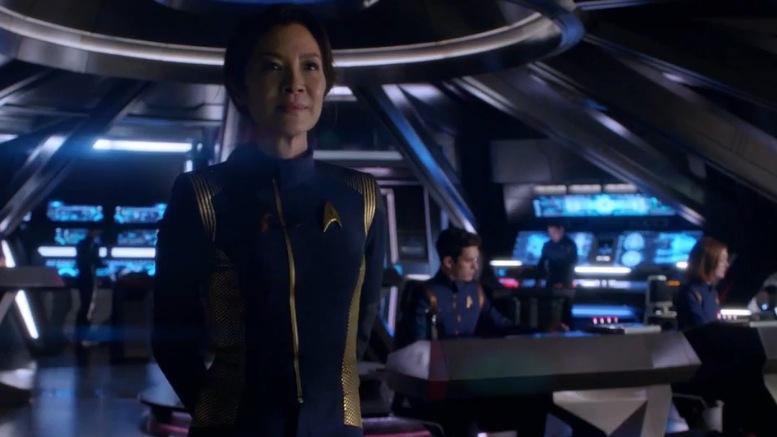
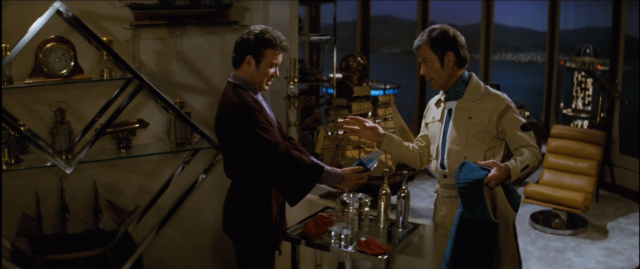
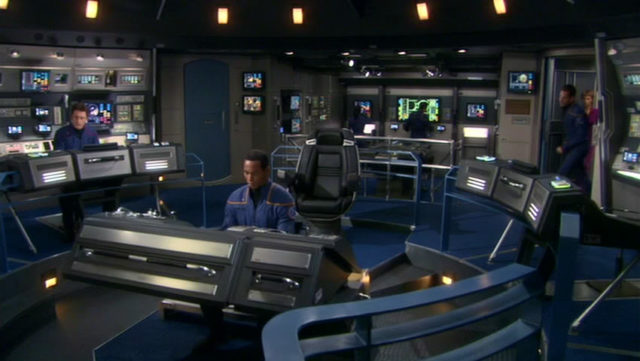
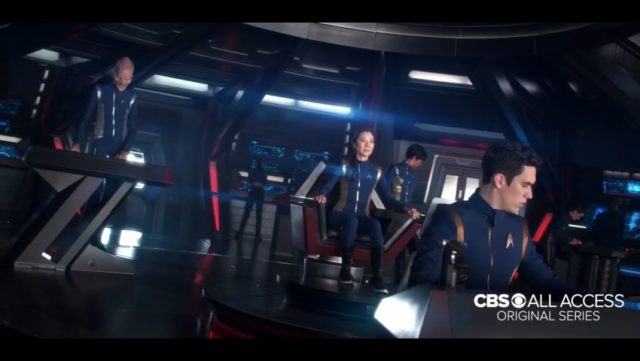

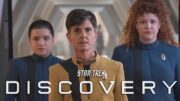
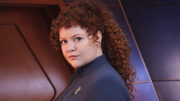
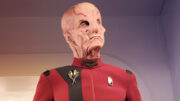
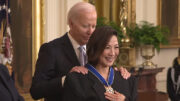
Headline correction: Nick Meyer
Fixed.
The Thing I ;ole about this show why its gonna be good is that they are taking stuff that was from the Original Series that Was Wagon Train to the Stars I cannot wait for it
Can’t wait for this damned show!!!
I’m keeping a very open mind but so far I’m encouraged by everything i’ve seen.
You know where I learned to keep an open mind? Batman Beyond. I grew up on TNG and Batman: The Animated Series, and when BB was announced, I had a very closed mind towards it. I didn’t want a futuristic Batman. I didn’t want a Batman that wasn’t Bruce Wayne. I didn’t like the look of the show because it was so different, I didn’t like the look of Batman (no cape?!) and despite their attempts to maintain a continuity, I refused to watch it for quite some time because I didn’t think it fit with BTAS.
But after a while, and after the show got over some early flaws, I realized it had it’s own voice, and yes it was different, but it was still great in its own way, and suddenly found myself getting nostalgic when they brought him back in the Justice League cartoon.
We were wondering.
Thats cool but a cartoon would never bother me because it’s not “canon”. Then again its different for certain franchises. Batman has been played by so many different people and had different looks and reboots. There is no canon for Batman other then the traditional modern re-telling of his origins and basic personality/powers.
Same with James Bond. That was the example many people used to compare with Trek, in that Bond can be recast and rebooted and no one goes nuts.
But Star Trek is a 50 year franchise that, for the most part, is one continual story. And while many writers and directors might love to reinvent Trek, to me, the fact they made it to 50 years old should be something celebrated and respected. Why reboot it now? Keep going.
One point, Batman Beyond is a part of what is known as the DCAU, the DC Animated Universe, a string of shows starting with Batman The Animated Series which shared continuity, including the Superman Animated Series, Justice League, Justice League Unlimited, & Static Shock. There is even an episode in Justice League (named Epilogue) which takes place 15 years after Batman Beyond & is all about that character. So in terms of the DCAU Batman Beyond is canon.
Its canon within its own universe.
The Dark Knight Trilogy is canon within its Universe too.
All the different Batman takes are not canon to “Batman” though.
Believe it or not, in VLC I’ve sometimes added a 2:1 “Univisium” custom letterbox to Star Trek episodes just to get a more cinematic feel. Really adds to the experience, even though it doesn’t always work, of course; naturally, some frame content will get blocked. But it’s fun seeing old Trek episodes in this way. Does something in your head. :)
@Schultz — seriously? That’s major cropping to a 4:3 Trek episode. 16:9 is pretty extreme, especially for TNG episodes which surprisingly made greater use of the full frame than even TOS. 14:9 is probably the correct aspect ratio to crop Trek, with adjusting the frame up or down. I’ve actually cropped a couple of episodes, adjusting the frame in each shot, and it actually improves the focus considerably, eliminating a lot of unused vertical space. But there are some tight shots that are just too close for 16:9. I can’t imagine what 2:1 would do to those shots. The only way to fix it would be to take a larger portion of the scanned 35mm frame and go wider to allow less of the vertical cropping, and that might not work in every shot, depending on how clean they kept the overscan area.
You’re right; especially in scenes on the bridge, with tactical higher than command, they often use the 4:3 to its full extent. (Maybe the bridge was even built this way, because they knew they would shoot in 4:3… who knows?) You tend to lose a lot of Worf & Tuvok, if the camera remains focused on the captains, even if the former have a line to say. Applying such a letterbox is far from perfect. It won’t work without and elaborate pan & scan, and even then you would still lose lots of great visual content. But it’s just for fun: it all started with 16:10 for my notebook screen, so I wouldn’t have black bars on the sides, then tried out 16:9 and even 1.85:1 at times. When I read about Univisium many years ago, I started adding that and other aspect ratios to the VLC menu, and even 2:1 works fine in some 4:3 scenes… with ENT anyway. But of course, this is *definitely* not recommended viewing. :)
@Schultz — oh right, ENT would have been protected for overscan in the parts of the screen that univisium affects. So you’d likely never know it wasn’t shot that way. TOS works brilliantly for over 98% of the content I have viewed in 16:9 cropped. Indeed they even produced the CGI shots in 16:9, evidently for TNG too. I think the issue with TNG is that there were a lot of established TV directors in the late 80s, who had come out of a system that taught them to compose shots creatively for 4:3. TOS had directors who were looking to get into widescreen features. James Goldstone who shot WNMHGB started solely directing feature films a few years after Trek. That pilot crops beautifully into 16:9 with no reframing. Joseph Pevney came out of wide screen features, and his episodes crop well too, as they were more cinematic. Also, many veteran directors had come out of an era where TV safe zones were much more conservative, so again they didn’t make as much use of the entire vertical frame, with a lot of center focus, and massive amounts of air above the actors. TNG has it too in shots, primarily because the entire ensemble cast is often captured spread out horizontally, so it can’t be avoided. But that’s likely one reason the bridge has such a disparate height split level plan.
You’d get a thumbs-up, if this were possible. :)
A lot of filmed shows were shot in the sixties with potential cinematic exhibition in mind (see some of the Man from UNCLE films built out of two part stories.) In Europe, the wide aspect was often still 1.66:1, so the 4:3 image, so the adaptation was easy. Bearing in mind that there was plenty of space generally left top, bottom and sides for telecine and overscan, the adaptation to cinema was pretty seamless. I remember playing with some archive TV news film footage when I was working as an assistant editor 20-odd years ago. I found it easily fitted a 16:9 frame and, with a little reframing, it even worked passably in 2.35:1.
Its kind of a shame TNG was shot that way. I dont know if, in the late 80’s there was a sense of where TV was going, but watching a youtube video explaining why TNG cant be remastered in wide screen, showed that *just* off-screen, they’d have their lighting rigs and other equipment.
So even if you wanted the wider shot, it would show filming equipment. Or the CGI was rendered to where, in widescreen, it abruptly cuts off at the 4:3 mark.
Yup. When they did that HD remaster of Buffy the Vampire Slayer, which was framed for 4:3 but shot on wider stock, all of a sudden you had crew appearing in the margins… Joss Whedon was totally opposed to it but unfortunately had no control over it. http://gizmodo.com/oh-dear-buffys-hd-makeover-is-a-total-mess-1671812347
@Fred — this happened to Sinefeld too. My favorite is the episode about “shrinkage” where George misses seeing his date to the Beach topless. When she walks out of frame, you can see that she’s wearing tape across her breasts, which was clearly never intended to be seen, and was considered clear during filming. Even without going back to the original Academy Aperture, and just opening up the full TV aperture for DVD release often reveals people waiting in the wings, who were once considered safely hidden in the overscan area. I still think TNG could have been salvaged at 14:9, or even 16:9 with a little manipulation of the frame, despite the dirty edges. Strategic stretching could fix a few of those scenes easily as there wasn’t a lot of camera movement in that show.
TNG was probably a bit too early. Maybe some trailblazers were already lobbying for 16:9 at the time, but later on the industry definitely knew: they shot all seasons of the X-Files in 16:9, and just cropped left & right for the original broadcast; the recent re-releases all went back to the original 16:9. Don’t know what happend regarding DS9 & VOY. DS9 started in 1993, as did The X-Files. They must have known that the broadcast world was going 16:9, so why did they shoot in 4:3? Beats me.
@Schultz — you can bet it was cost. To shift their entire post production assembly line to 16:9 1080p when it was going to end up 4:3 was not an option for a studio that was maximizing profits off these cash cows. I wouldn’t be surprised if the frame wasn’t protected for 16:9, with centered action, unlike TNG. If so, it would be a matter of going back and repeating the Post Production process all over again as they did with TNG. That’s essentially what X-Files and Sinefeld did, but without the expensive CGI. And that’s the thing that will ultimately slow the process of remastering DS9 & VOY.
They won’t remaster DS9 or VOY for that very reason. The sales of the remastered TNG sets were not as brisk as anticipated. The production team that is working on the upcoming DS9 documentary is going to remaster a few scenes themselves. That might spur some interest in a remastered DS9, but I wouldn’t get my hopes up.
Many of us who have double (or triple) dipped on TOS and TNG might not be keen on going to the well again for DS9 and VOY. At least, that’s what the suits at CBS/Paramount Home Video probably think. Streaming is the future, but I’m not sure that streaming revenue is strong enough to warrant spending the millions of dollars it would take to remaster even one of those series.
But, never say never…
“There’s a hint of all of them, but in the writers’ room people are so in love with The Original Series and Next Generation, and they talk about the family aspect of those cast members.”
This comment warms my heart. I was really worried they were moving too far away from the original spirit of the franchise. But this comment is very reassuring.
I agree. I love the morality play aspect of Star Trek and the glimpses of other societies, and the science fictional storytelling. But at the end of the day, much of what makes me LOVE the characters is the way they treat one another. Watching Spock risk the death penalty to take care of Christopher Pike in “The Menagerie” or watching Kirk risk losing his career to save Spock’s life in “Amok Time” never gets old for me.
Keep dreaming according to this article they are throwing out the Roeddenberry rule book yay Have ‘Star Trek: Discovery’s Changes To Canon Strayed Too Far Off Course? https://moviepilot.com/p/have-star-trek-discoverys-changes-gone-too-far/4303405
That’s serious FUD article stuff there. The Roddenberry rule is a circa 1987 Roddenberry invention, there was no such mandate back in TOS. So that’s not really a cause for concern.
They’re not throwing out a “rule book”, that makes it sounds like there’s this whole bible of things they’re ignoring, when it’s the single TNG-era rule we’re talking about here.
Here’s our more balanced coverage of the same topic:
https://trekmovie.com/2017/06/23/showrunner-talk-about-universe-changing-decision-at-heart-of-star-trek-discovery/
Here’s TrekCore’s too so you can see another example of what more reasonable coverage looks like:
http://trekcore.com/blog/2017/06/new-hints-about-star-trek-discoverys-storyline/
Not only that, but the edict that their couldn’t be any internal conflict among the main cast went out the window with DS9. Sure, they found excuses, like making the crew Bajoran militia, or Maquis, but there was still plenty of conflict.
And on Enterprise there was tons of conflict among the Starfleet crew.
Thanks for the Link and I am excited they are throwing out the Rule book it just does not work for new audiences of today.
Warms your heart?
They like TMP. I almost fainted!
It’s really the only of the TOS movies that actually aspires to be a *film,* and 70s futurism ascetics aside, has aged really well. I also think this bodes well for Discovery.
TMP is the only ST movie faithful to Gene’s vision.
>> TMP is the only ST movie faithful to Gene’s vision.<<
And TMP had TONS of conflict between Kirk and Decker. Not to mention all the other characters like McCoy's snarky response to Spock when he first comes board.
Yeah, in terms of “scope and scale”. That doesn’t mean story, pacing, character development, etc.
It has nothing to do with “scope and scale”…all the rest of the films are moronic space opera battles with bad guys seeking revenge. Fanboy films.
BTW: My personal *subjective* favorite is actually TSFS. But I’m stating a fact re: Gene’s vision and TMP, as it’s the *objective* truth. But TSFS is still my *subjective* favorite, followed by TFF. Those are the two I watch for “fun” and entertainment.
They’re saying all the right things; they just need to show us.
Show Don’t Tell: https://www.youtube.com/watch?v=tiIPe9ow-BI
(It’s one of the most rudimentary writing lessons.)
What is it you would want them to show you at this point, that wouldn’t give the game away?
Michael Hall
What is it you would want them to show you at this point, that wouldn’t give the game away?
You’ve never seen a compelling trailer or ad for a movie or TV show that didn’t spoil it for you?
How about something like this: https://www.youtube.com/watch?v=8X5gXIQmY-E
Does that trailer spoil the entire series?
Neat. I’m a big fan of The Expanse, particularly after it’s improved sophomore season. But while I’d agree that this trailer (which I’ll stipulate is better than the DSC trailer for a number of aesthetic and technical reasons) doesn’t “spoil” the show, it really doesn’t give an accurate sense of what it’s about either, let alone who the main characters are and how they relate to each other.
For me the DSC trailer overall was adequate, an uneasy mix of the awkward and the pretty cool. The best trailer by far I’ve seen recently is the one for Game of Thrones, though that had the advantage of a very compelling backstory going in.
Michael Hall
The Expanse trailer isn’t the most compelling trailer ever made, but it does give you the basic premise of the story arc for the season, that being a political conflict over resources. This tells us that the show is not set in an idealized future, but rather a gritty all-too-realistic one. Just from that we get a solid sense of the mood and tone of the show, as well as what sort of issues are likely to be treated. What’s the mood and tone of DSC? What sort of issues are likely to be treated? Will there be much in-fighting within the Federation? Will there be a regular political allegory played out between the Federation and some alien race (as with the Klingons in TOS)? Your guess is as good as mine. I found the DSC teaser totally worthless. It showed me nothing interesting, and told me less.
Well, we’ll have to agree to disagree. Watching that trailer you’d think that a major plot point of The Expanse is the despoliation of Earth in the 23rd Century, while in the actual series it’s an intriguing subplot and relegated very much to the background. Meanwhile there’s no mention whatsoever of the protomolecule, the show’s main McGuffin and plot-driver. Nor is there even a hint of the character dynamics and relationships that are often at least as compelling as the somewhat muddled plotting (particularly in the first season).
The Discovery trailer is fairly clunky but does at least establish the main viewpoint character, her relationships with her C.O. and a beloved figure in the Trek mythos, as well as showcasing some expansive (and expensive) production values. Far from worthless IMO, but to each his own.
Michael Hall
We’re not really disagreeing about what The Expanse trailer shows. I never said that it was a perfectly accurate trailer, nor that I was looking for perfect accuracy in the DSC trailer. What I’m looking for is substance. Some hint of what the show is going to be like. What it’s values and sensibilities are. What sort of issues it plans to be about. It doesn’t matter all that much to me whether they show us substance in the form of character dynamics and relationships or thematic concepts. The Expanse trailer shows us something of the seasonal and series overarching theme. The DSC shows us nothing thematically or character-wise. I suppose we do disagree on what DSC shows us. What it shows us of the characters is nothing, as far as I’m concerned. It’s certainly nothing worth mentioning. So, there’s a character who thinks that her subordinate deserves to be captain–so what? That’s not interesting. And neither do the production values tell me anything that I didn’t already know. Slick production values for a show like this are par for the course. It’s about the one and only thing that you can count. So, to see them measure up to expectations doesn’t show me anything, either. After all, I wasn’t expecting DSC to look like a fan film or dated, like it was made 20 years ago.
P.S. What I mean by, “So what–that’s not interesting,” is why should I care? Why should I care that a character I know nothing about thinks that another character I know nothing about should be a captain? Why would that be interesting to me? Why would I care? And that’s all that the DSC trailer shows us of the characters. One of them thinks that the other should be a captain. Is that really a thought-provoking or compelling concept? Am I missing something?
Well, I happen to think that the mentor relationship with Sarek, which apparently extends back to the lead character’s childhood, is potentially very interesting indeed. I’d say that in and of itself, along with the serialized nature of the show, which will almost certainly make it very different from any previous iteration of Trek, would be enough for me to give the show a decent chance. You feel otherwise; and that’s fine. But I’ve loved this franchise through all the hype and inevitable disappointments (which is why I paid good money to see STAR TREK BEYOND and INTO DARKNESS even after the cosmic awfulness of Trek 2009). So CBS will get my subscription dollars for at least a few months, but if it turns out that DSC sucks, rest assured I won’t be afraid to say so.
Michael Hall
Fair enough.
For the record, I paid good money to see STID in the theater, but am proud to say that I drew the line at STB. I don’t believe that supporting the direction that Bad Robot took the franchise is good for the Star Trek brand long-term, and it’s certainly not good quality-control for the content of future Trek movies. At some point, when all of the meaningful fundamental attributes of TOS are no longer present in a product, it doesn’t seem right to keep calling it “Star Trek.” It’s sort of the opposite of the old Polaner All Fruit commercial: Paramount and Bad Robot can make whatever Trek rip-off they like, and make it as dumbed-down, shallow and superficial as they like, but, please… Don’t call it Star Trek.
Polaner All Fruit (1989): https://www.youtube.com/watch?v=KS8YKqZMSE4
How is this different than prior to any premiere? For example, the first couple of these DS9 promos don’t say or show anything, and they aired just a couple of months before the first episode… https://www.youtube.com/watch?v=RmT-Dxuj8U8
VoR
I don’t recall even having seen those DS9 teasers. And it didn’t matter, because Paramount didn’t need to sell me on the show. As far as I knew, the same people who had made the amazingly awesome TNG were making DS9, a spin-off series with the same general setting (24th Century, Milky Way Galaxy, Star Trek universe). And that’s all that I needed to know to tune in for the first few episodes and give the show a chance. DS9 didn’t require a monthly subscription service, so it was an easy matter to just tune in where ever I happened to be when the show aired. What’s different about DSC? Pretty much everything: (1) a totally untested and largely unknown production staff (with the exception of Nick Meyer); (2) the head exec (Kurtzman) is substantially responsible (along with Orci and Abrams) for despoiling the Star Trek brand; (3) the studio (CBS) producing DSC has never produced a Trek series or movie; (4) there is no good will (on my part) carrying over into DSC as there was from TNG to DS9, but rather a bit of the opposite (due to item #2); (5) DSC will require a paid subscription to follow. So, that’s how it’s different.
They dont really need to sell you on the show. If you want to see it, you will. I understand what you’re saying, but they are also relying on positive word of mouth, which means they have a vested interest in it being good.
I strongly suspect they are withholding information due to creative reasons (spoilers etc). I respect that. Im going to watch it anyway, do I need to see the Shenzhou blow up in the teaser trailer?
There will be more trailers with, surely, more info. Give it time.
TUP
Well, they definitely need to sell me on the show if they want me to give it positive WOM. As for seeing it, they actually do need to sell me on that, too. As it stands right now, I have no plans to subscribe to CBS All Access and not much interest in DSC, simply because there seems to be an equal likelihood of my liking it as disliking it. The reasons that I feel that way are what I described above. If CBS were to show me nothing compelling about DSC, would I still be curious to see it? Sure. But, when would I get around to it? Maybe a year from now I’d sign up for a one-month subscription to watch the whole season? Maybe sooner, if I heard good things about it from people whose opinions I respect? Who knows. The point being being that I have A LOT of good shows to watch these days, and DSC is presently not high on my list, simply because I have no reason for it to be. If CBS wants me to give the show good WOM, and make it a viewing priority, yes, they’re going to have to give me a compelling reason. And, I’ll give it all the time it takes. As I said, I’ve got plenty of other shows to watch. I’m just reacting to these articles in real time with my real opinions.
I will admit, though, that it frustrates me a tiny bit each time that CBS puts out a story about DSC in which they talk about the show in generic terms, like “intelligent…gritty…complex…,” rather than show us a small demonstration of those attributes. That’s what I don’t understand. If they don’t want to talk about the show yet, then don’t talk about the show yet. But, if you’re going to do something, then do it well. If you’re going to promote a show, then promote it with substance. As demonstrated in The Expanse trailer, it’s not a choice between spoiling the show and promoting it with substance. TV shows and movies regularly promote their products without spoiling them or giving away too much. It’s the marketing strategy and tactics for DSC that I find fault with. If the goal is to get people excited about the show, then show them something exciting! If the goal is to keep people in suspense, then stay quiet! It’s these half-measures that I don’t get. To me, they verge on communicating that the show actually doesn’t have much to offer, and that’s why the promotional material is so weak.
All good news. Discovery won’t be loved by everyone but I do think if people give it a chance and can get over its not really a prequel to TOS (in terms of the look) and see it as its own thing I think people will be surprised.
It’s not meant to be viewed on the big screen so why are they “splitting the difference” at all when it does not fit perfectly into everyone’s TV? Letterboxing happens because of aspect ratio disparity, it should never happen by design.
I mostly agree, though it does allow for more “cinematic” framing of shots that you just couldn’t do at 16:9.
Does anyone know if CBS-AA is capable of 4k streaming, yet? I’m sure they’re recording at 4k (or higher).
UI thought I heard they were filming at something less than 4K but sufficient enough for quality 4K upconverting. I dont know if that is true. I would hope its 4K. Or 8K.
You’re not going to compete in the streaming market if you cant stream modern tech (even if thats not available at launch). For me, Im Canadian so Im watching it on SPACE anyway…so likely 720P and my TV can do the rest.
If they are actually using film, then the raw footage is already at a higher resolution than 4k. My educated guess is that they are either shooting digitally at 4k or 8k or they’re shooting film and transferring to 4k video, for post. The 2:1 aspect ratio would suggest it’s the latter; many pro video cameras that support resolutions above HD boast 2 different 4k aspect ratios: 16×9 and 2:1. I would be shocked if the finished product wasn’t 4k, regardless of what resolution CBSAA ends up streaming.
Wish I knew somebody on the CBS post team so I could confirm!
Probably finishing in 2K DI. Majority of movies are finished like that and up-rezzed to 4K for UHD Blu-Ray. It’s a lot cheaper to finish the CG at 2K then convert if needed.
Would be nice if CBS offered 4K streaming though. One can hope.
Interesting. We don’t do much high end CGI where I work (mostly logos and stuff), so I hadn’t heard about people rendering out in 2k. It’s a little surprising they don’t do 4k 2:1 for the Netflix 4k stream. We’ve noticed upconversion of CGI material tends to suffer more than upcoverting material captured in a camera – more artifacts are generated for some reason. On rare occasions where we’ve upcoverted projects, all of the on-camera stuff was just pushed through a high end converter like a teranex or something, but the graphics had to be redone because they looked much worse than the live action stuff.
They are not using film. Even JJ Abrams isn’t using film anymore. The finished product will almost certainly be 4K, but there will likely also be other resolutions to accommodate different connection speeds.
I wasn’t aware that JJ had gone fully digital. Into Darkness was shot mostly on 8-perf 65 MM with a little IMAX thrown in for the Volcano scene. I remember an interview with (several years ago) where he was quoted as saying that he still prefers the look of film. Maybe he’s changed his tune since then…?
You are correct that fewer and fewer people are using it, though. With 8k HDR, it’s getting harder and harder to distinguish between film and video. Ironically, many of the speed gains of using video over film diminish as you increase video resolution, mainly due to the amount of data involved. The amount of storage needed also drives up the post production cost.
@nscates — that’s my bad, I never kept up with how the Star Wars saga ended … I only remembered that Disney originally wanted it shot in digital. Guess Abrams won that one. But BEYOND was shot in 3.4k/6k digital, despite Abrams producing. Still, it’s hard to believe they would shoot a TV show on film.
They are splitting the difference because they don’t care about TV screens, they care about art & craft, and telling a great story, which by definition includes the visuals as well. And if a genre is made for the new 2:1, it’s science fiction. But if you want, you can crop away some content left & right and zoom the image to 16:9. Then it will fit perfectly. (They are probably shooting for combined 2:1 & 16:9 anyway; most productions that go “wider than usual” do, and the DoP will make sure that the relevant visual content is always within the 16:9 area of the frame.)
I can say that back in the 90’s when we would rent a movie and it was letter boxed, we would be irate. Now that Im not a stupid kid, I get it.
Plus, it has never bothered me. Im not even sure I could tell you of all the shows and films I’ve watched at home in the last six months, which were full screen or not. You simply dont notice after about 30 seconds.
But most modern TV’s will allow you to fix the letter boxing. Zooming/stretching etc.
The big question is whether they will letterbox the image on the Blu-ray or UHD version or will they encode it at it’s true resolution, even anamorphic encoding maybe.
The original 2:1 Univisium is spherical, not anamorphic, and anamorphic prints for screening are only a compromise, if I remember correctly. With digital film production, they are probably also shooting spherical. Don’t know how they do it later in broadcast and on home video formats. Standard DVD/BluRay 16:9 anamorphic, with the 2:1 letterbox part of the 16:9 signal?
I doubt they are using film though which is what the Univisium format was designed around. So if they are shooting digital, then they either have to use an anamorphic lens to get 2:1 or they have to crop away some of the resolution from the sensor.
But I was mainly talking about the distribution later on.
With historic DVD distribution in order to get a 16:9 image they could either crop a 720×480 image down to 720×360 (putting black bars on top and bottom), or they could use an “anamorphic” method where they kept the full height of the 720×480 image and let the DVD player stretch the width back out to a 16:9 ratio. Anamorphic DVDs made a big difference once we switched to HD displays.
Presently the prevailing format is 16:9, but can they do a similar anamorphic distribution to maximize the resolution or will they be cropping the 1920×1080 image down to 1920×960 and throwing away the extra data? Does CBS:AA or Netflix support variable ratios, I wonder?
The main reason I’m wondering is that there are phones and extra wide monitors starting to come out in 2:1 and 21:9 ratios and the trend in home theater projection is to have a fixed height screen while adjusting the sides to match the content. Having natively encoded 2:1 video without black bars will help content on these new screen types look right with minimal hassle.
It’s more common than you think for films and TV series to play with aspect ratio. LEGION, for instance, does interesting things switching between letterbox and full screen. And of course films shot in IMAX use a different aspect ratio. Don’t be so quick to say “creative people should never do X.”
American Gods also switches around, 2.39:1 for the flashbacks, for example. And with VOY, if it had been shot & broadcast in 16:9, it would have been awesome to have Tom’s b&w holonovel in 4:3. ;)
This I’m actually disappointed with because it’s a TV show being watched on a 16:9 screen not much trek has been shot this way and I was looking forward to seeing more of it that way. I don’t see the point of doing 2:1 in this situation.
They are surely also shooting (composing the shots) with 16:9 in mind, i.e. as with other films or series, for certain foreign markets, there might be 16:9 version, with some of the content cropped away from the left and right of the frame. Then you can still look forward to seeing it in 16:9. Myself, I thoroughly enjoy the 2:1 format, e.g. on House of Cards; you can go cinematic, if you want to, but it’s also very much suited to tell a more intimate scene. I wish there were more shows (and films!) in 2:1.
I find its a format that is really something and nothing, 16:9 is for TV screens, cinema scope is for cinema screens etc. But 2:1 I’ve never truly enjoyed or seen the purpose of. But I think this is a small detail I’m generally very excited to see Discovery, I’ve really missed Prime Trek.
I really agree with TomR’s comment. Deliberate letterboxing is just cheating the public, taking away 11% of your screen and putting black stripes there. This is the worst news I’ve heard yet about Discovery.
@ Binyamin: You said: “This is the worst news I’ve heard yet about Discovery.”
This seems like an overly dramatic statement in the context of all the info they have released about Discovery up to now. But I guess that everybody has different priorities. Or maybe you have liked everything you’ve heard up to this point, so the first bad news is automatically also the worst…
How do you know they are *letterboxing*, i.e. shooting native 16:9 and adding black bars top & bottom? They could very well be shooting in native 2:1 and cropping left & right if they ever need a 16:9 version; then the 2:1 would be the original, and all (hypothetical) 16:9 versions would be deliberately stripped down, with less content. Do you have any technical insights into this aspect of the production?
@TomR — you sound like my 80 year old mother who watches all her movies stretched because she hates the black bars and doesn’t feel like she’s getting her money’s worth.
@Curious Cadet – I watch all pictures in their native format whether it’s 4:3, 16:9, 2.40:1 or anything else and Discovery will be no different. I’m just saying how I feel about this creative choice which I am well within my rights to do! If you don’t like it remove yourself from the thread!
@TomR — it’s a creative decision which someone feels is important, just like the decisions made to shoot all those other movies you watch in their native ARs. Just because you don’t appreciate the decision because it won’t fill your entire 16:9 TV screen doesn’t make it wrong from a creative perspective. And im just saying how I feel about your comment, which I’m well within my rights to do! And my 80 year old mom doesn’t see the point in showing programs with black bars. If you don’t like it … Well let’s just leave it there. ;-)
I don’t know which is worse, the bridge from Discovery or the bridge from Star Trek 2009.
2009, and by a long shot.
I assume that this show is being shot in 6 or even 8K. This can mean that shots can be reframed in post and presented in 4K in almost any aspect ratio. Does anyone know what camera the show is actually being shot on, and/or what the digital negative is?
Over at Trekcore, somebody in the comments speculated (based on the monitors seen in behind the scenes shots) that they may shoot the show on an Alexa camera that has 3.4K. They may also use a higher res Alexa camera which (according to that commenter) is usually only used for movies.
I am under the impression that minimum deliverable for Netflix original series is 4K – but I Have no ide s as to how that is created along the way. IDK why they would start a new show thinking about uprezzing.
@Trek in a Cafe — Netflix requirements wouldn’t matter for DISC. However, I can’t imagine any production not shooting in 4K at a minimum. And considering that CBS did a special widescreen crop of TOS Remastered for Japan, they obviously know the importance of having 8K product for the future.
Anyone hear any word of Discovery being offered for purchase on ITunes? I checked last night on my Apple TV, and The Good Wife is available there, another “CBS Access-Only” show. Makes sense to me they would offer this on ITunes, too. Matt Wright? Anyone?
I’m sure they’ll eventually offer it just like they offer it on Blu-ray at retail locations and downloads from Vudu, Amazon, and Google Movies. So the main question really needs to be, how soon will they offer it on iTunes. My guess is you probably aren’t going to see it on iTunes and other download stores until right before the Blu-ray is available. Considering how they are pushing CBS All Access, offering it on iTunes next day would be like shooting themselves in the foot.
JJ’s influence on the Star Trek franchise has been reasonably positive. However, if they dare put all that lens flare crap in the series, I’m not watching it.
Read between the lines and it looks like they are crediting JJ with just a stylistic influence and everyone else for the actual substance.
Hard to say that when it doesn’t really look anything like BR/KU Trek …